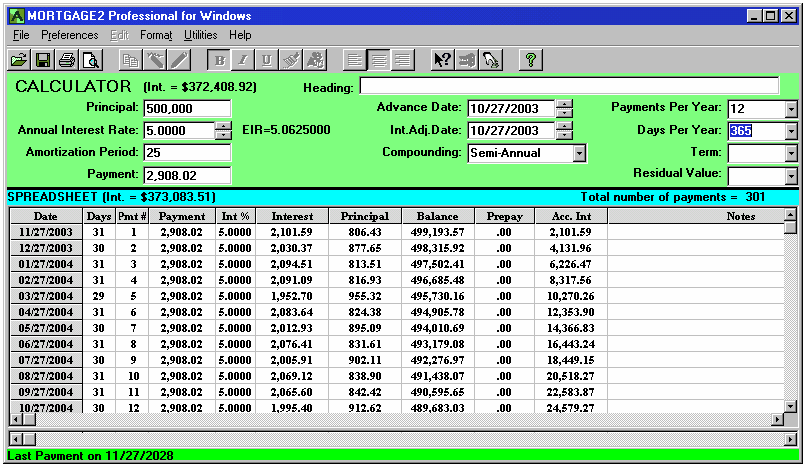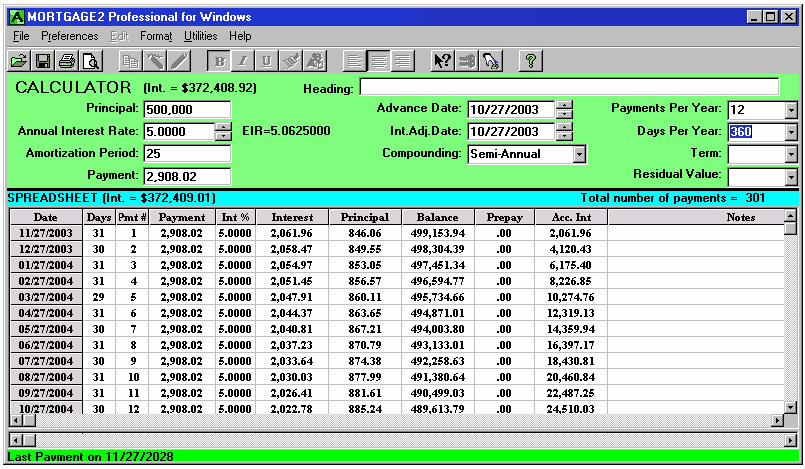National Debt
The exact amount of the current National debt (March 31, 2004) is very difficult to state for many reasons. The only figure I would believe is directly from our current Prime Minister. As Prime Minister he must be aware of this information. Newspaper articles are only approximations because traditionally our Federal government has been reluctant to disclose in detail this type of information.
The examples concerning the National Debt, on this site are for illustrative purposes and to convince Canadians that a simple amortization schedule is not ROCKET SCIENCE. Amortization schedules have been around since 450 BC when Nehemiah, the governor of Jerusalem revised the usury laws.
As a concerned Canadian, I urge you to write to the Honourable, Prime Minister, Paul Martin and ask him why Canadians cannot be informed, via the Federal governments web site, about the National Debt as an amortization schedule. The National Debt amortization schedule could be updated as often as the payments are made and as often as the interest rate changes. Thus, all Canadians could have 24 and 7 access to our National debt information. I believe disclosure and accountability are part of the Prime Ministers current mantra. Its time to walk the talk.
For example; Consider a 500 BILLION dollar Canadian mortgage at an annul interest rate of 5% amortized for 20 years. If the interest rate drops to 4%, the monthly interest cost drops by 409 Million dollars which is almost 5 BILLION dollars savings per year. Canadians need to know these numbers
because the government would have 5 BILLION dollars more of our money at their disposal. Whether they pay down the debt or put it into other programs, we need to know. Its our money!
Paul Tuns article, “Debt monster yet to be tamed” 03/03/2000 Hamilton Spectator, should be printed over and over again. It should be on the front page of every major Canadian newspaper every day for one week. It is crucial to note that the Canadian Taxpayers Federation and the Fraser Institute both suggest the government “create a timetable for debt reduction”. I agree totally. Canada’s national debt timetable needs to be shown as an amortization schedule. An amortization schedule is a timetable or chronological payment history showing the payment and the balance owing after each payment. An amortization schedule is a financial road map showing you how to get from a place of debt to a debt free place. Once you see an amortization table you know exactly when the debt is paid off, and exactly how much interest was paid to the lender.
Below is Canada’s national debt in the form of an amortization schedule.

All numbers in the above schedule must be multiplied by 10,000 as the schedule is for $57, 680,000. An interest rate of 7.2% was used and it was arrived at by dividing the yearly interest charge of 41.5 billion by the total debt of 576.8 billion dollars.
If the Federal government pays just the monthly interest of 3.41 billion (41 billion per year) the national debt will never be paid. If the government pays the monthly payments of 4.11 billion ( 49 billion per year) the national debt would vanish in 25 years. Spreading the National debt over a longer time span is ludicrous because even at 25 years the interest alone is almost 657 billion dollars which is more than the debt itself. It is interesting to note that the short fall is just 8 billion per year. Considering the squandering and misallocation of government revenues of late, this is not an impossible task! The argument that all other industrial countries are in debt and in worse condition is false logic.
It is wrong to put future generations in debt.
The current Canadian Federal government spending is in excess of 160 Billion dollars per year. Why can’t a responsible government allocate an extra 8 billion per year in order to retire the National debt in 25 years? The government of Canada must hold a plebiscite in the next election and ask Canadians how to spend the revenues so that we pay off the National debt in 25 years. When the national debt is paid an extra 49 billion dollars per year would be available for important social needs that would improve every Canadians standard of living. Canadians must stop being fooled by politicians playing shell games with revenues. It is our money!
For a recent discussion (October 29th 2003) of Canada’s national debt and how the federal government could save 63 billion dollars in interest, (below).
Canadians must wake up before it is too late!
Ron Cirotto, BASc. P.Eng.
National Debt Interest Savings
63 BILLION dollars in interest savings.
Canadians deserve some “thinking outside the box” regarding Federal finances. I have a “made in Canada” solution to reduce interest costs on our national debt. My solution is based on several assumptions. The critical assumption is that the loan is being paid with monthly blended payments.
Let’s assume Canada’s national debt is held by a fictitious Benevolent Bank of Canada (BBC). I will keep the numbers simple. Let’s assume the current national debt is 500 BILLION dollars (its been quoted as 507 BILLION on Oct 24th 2003) at an annual interest rate of 5% for the next 25 years with blended monthly payments. Instead of the Federal government paying monthly payments to the fictitious BBC why not pay the BBC weekly payments and minimize the current interest costs? After all, weekly payment mortgages were invented in Canada in 1984. The following example is based upon a $500,000 loan. Multiply the numbers by one million dollars (6 zeros) to arrive at the approximate national debt figures.

By paying back the national debt using the minimum blended weekly payment of $669 million dollars the Canadian government would save taxpayers 2.56 BILLION dollars over 25 years. A financial calculator would confirm these numbers.
By paying back the national debt using the non accelerated weekly payments of $671 million dollars the Canadian government would save taxpayers 5 BILLION dollars over 24.86 years.
By paying back the national debt using accelerated weekly payments of $727 million dollars the Canadian government would save taxpayers almost 63 BILLION dollars over 21.41 years.
The savings look unbelievable but they are fact! The interesting figure, I call “free money”, is the 5 BILLION dollar savings for doing absolutely nothing other than paying the non accelerated weekly payment instead of the traditional monthly payments. It’s the same amount of money each year but paid back weekly instead of monthly.
Should our Federal government choose to continue with monthly payments despite the incredible interest savings achieved by weekly payments, there is another avenue that produces less substantial but significant savings nonetheless.
It must be determined if the BBC lender uses a 360 or a 365 day year schedule. A 360 day year schedule will save Canadian taxpayers 674 million dollars in interest compared to the 365 day per year schedule. Any page of an amortization schedule will make it apparent which number (360 or 365) was employed. All mathematical formulas hardwired into financial calculators are based upon a 360 day year. In fact there is no provision to input the days per year on any financial calculator. The interest factor per period is assumed to be constant because of the algebraic equations. Therefore, an amortization schedule is absolutely imperative in order to verify which type of schedule is being used.


365 Day
360 Day
The SPREADSHEET amortization schedule interest for the
365 day year schedule is $373,083 vs $372,409 for the CALCULATOR in the 360 day year schedule. The difference multiplied by one million (6 zeros) is $674 million dollars.
Back to the weekly payment solution! With interest savings to taxpayers, of 63 BILLION dollars over approximately twenty one and half years, the government in Ottawa should employ this type of debt repayment strategy immediately or as soon as possible.
63 BILLION dollars can go a long way in raising the standard of living for all Canadians.
